Bulletin – January 2000 The Impact of Y2K on Financial Markets in Australia
- Download 37KB
Effects on Short-term Interest Rates
As in other countries, financial markets in Australia were affected in 1999 by the so-called ‘Y2K’ problem – that is the uncertainty as to whether computer systems would recognise the century date change. The effects on financial markets were due to banks and other market participants taking steps to arrange their balance sheets and operations to limit the impact on their businesses of any serious computer malfunction.
Although the direct impact on financial markets of flows associated with Y2K was likely to be concentrated around the end of 1999 itself, markets began to anticipate the possible effects as early as a year ahead. Generally, these pressures were most evident in the pattern of short-term interest rates.
Concerns about the capacity of financial markets to handle pressures at the end of 1999 first became apparent towards the end of 1998 in the pattern of yields on bank bill futures contracts, with expected yields on securities maturing over year-end being higher than those on surrounding maturities (Graph 1). This pattern later extended into yields on physical securities and continued through the second half of 1999 (Graph 2). Markets consistently expected that short-term interest rates would be higher, on average, in the 30 days from mid December to mid January than in the periods immediately before or after.[1] This reflected the fact that borrowers were keen to issue securities maturing early in the new year, in order to secure funding over year-end, while lenders were reluctant to commit to investments over that period.
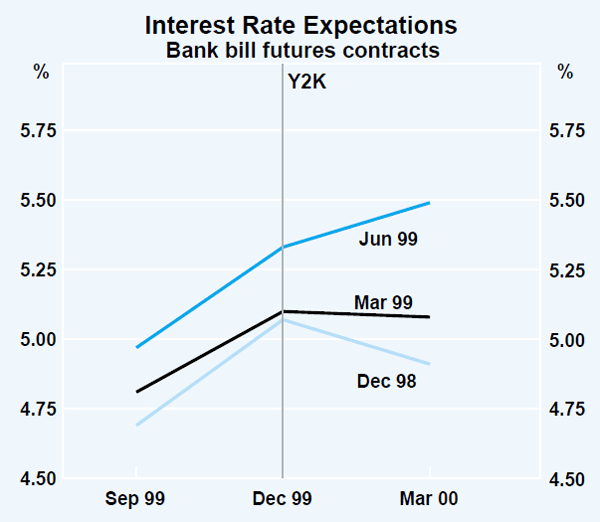
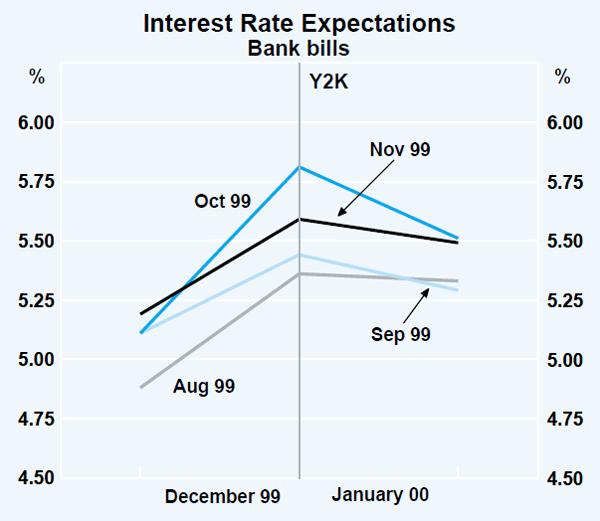
A similar pattern in yields – in most cases even more pronounced – was evident in all major countries. This can be seen in Graph 3, which plots the evolution of the Y2K ‘spike’ in major countries, calculated as the margin by which yields for the 30-day period spanning year-end exceeded those for the preceding and subsequent 30-day periods.
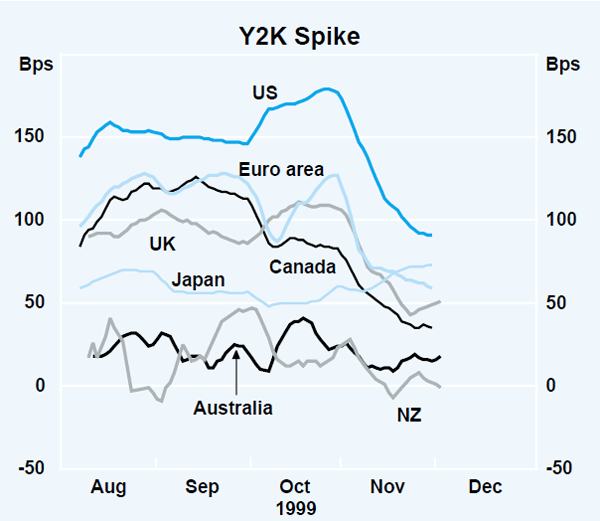
This pattern meant that, as year-end approached and short-term securities began to have maturities spanning year-end, their yields began to rise. Yields on 90-day securities, for example, rose noticeably in early October as these securities began to span the turn of the year. This can be seen in the case of Australia in Graph 4 and in the case of some other countries in Graph 5. Yields on 30-day securities, on the other hand, rose in December when their maturity also began to span the turn of the year. At the very end of December, yields on all short-term securities fell sharply as markets became convinced that Y2K pressures would be handled comfortably and concerns about the quality of bank risk receded. These lower levels of bill yields were sustained into January.
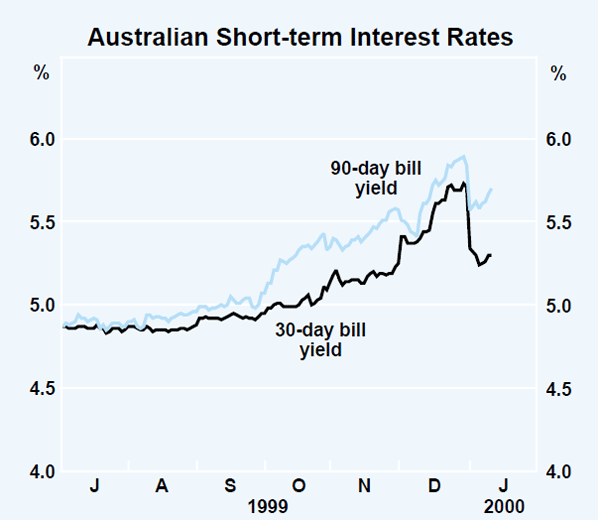
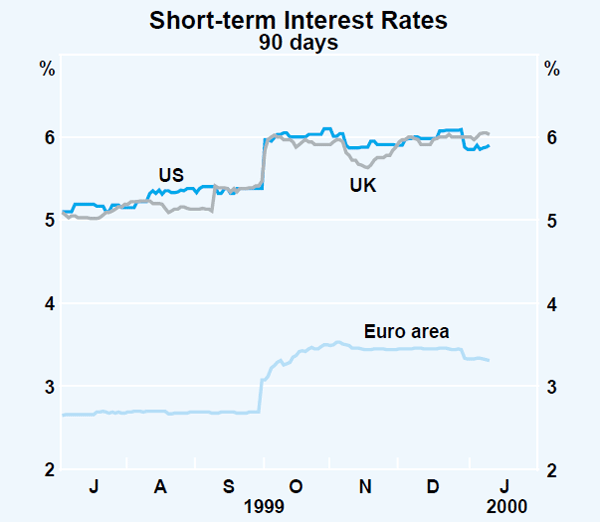
Yields on short-term government securities rose by much less than those on bank bills through the closing months of 1999, largely reflecting the greater liquidity of short-term government securities. While the Reserve Bank had announced that it would, if necessary, accept bank-issued securities to help manage liquidity flows around year-end, there was greater certainty about the liquidity of CGS, as the Bank would continue to accept them as a matter of routine. As a result, the margin between yields on Treasury notes and bank bills widened noticeably, from about 20 basis points on 90-day securities in mid 1999, to 80 basis points in late December (Graph 6). As the year turned uneventfully, the premium investors attached to the liquidity of government securities declined. In early January, the margin between bill yields and Treasury note yields fell towards the more normal levels of mid 1999. Again, a similar pattern was apparent around the world.
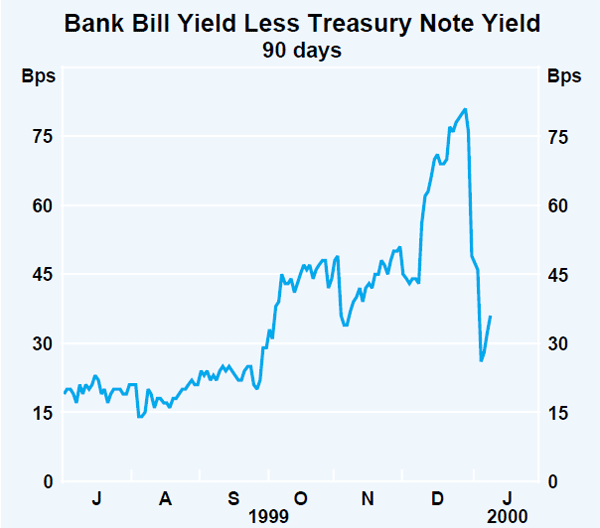
Households' Holdings of Currency
A major concern relating to Y2K was that households might withdraw much more money from financial institutions than they usually would at this time of the year. This reflected public concern about disruptions to automated teller machines (ATMs) and other electronic payments mechanisms; however, fears about financial institutions losing records of deposits were limited. The public's holdings of currency always rise strongly at Christmas time; notes then flow back to the Reserve Bank in late December and early January (Graph 7). Taking account of the buoyant economy and trends in currency holdings earlier in 1999, the Reserve Bank had forecast that the ‘normal’ rise in notes on issue (holdings by the public plus currency held in banks' vaults) between mid November and Christmas would be about $2.2 billion; other things equal, the Bank forecast that this would be reduced to about $1.7 billion by end December, with the remainder of the pre-Christmas rise being reversed in January.
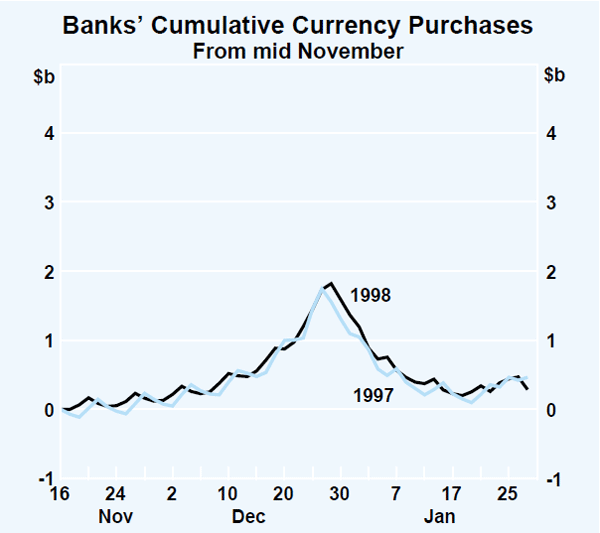
While the public's behaviour in response to concerns about Y2K could not be predicted with any confidence, polling on behalf of the Reserve Bank suggested the likelihood of some significant additional demand for currency at year-end. When the polling first started, it pointed to additional demand of $6–7 billion, but this estimate gradually fell to around $4 billion in subsequent polling.
In the event, banks' purchases of notes from the Reserve Bank were significantly larger than could be explained by the normal seasonal pattern but smaller than was suggested by the polling. Banks' cumulative (net) purchases of notes from the Reserve Bank between mid November and end December were about $4.2 billion (Graph 8). Taking account of the Bank's forecast seasonal rise (and the fact that this peaked on the first working day after Christmas), the banks' additional demand for currency notes due to Y2K was about $2.5 billion, or about 10 per cent of the normal stock of notes on issue. This included not only currency purchased to meet customer withdrawals but that required for a precautionary build-up in banks' vault cash. While at this stage final figures are not available, it appears that most of the $4.2 billion of the currency purchased by banks remained with them. These purchases of currency were quickly unwound in January. By early in the second week of that month, more than half these purchases had been returned.

Footnote
While this ‘spike’ clearly reflected Y2K concerns, the tendency for the level of expected interest rates to rise in the second half of 1999 reflected market expectations about monetary policy. [1]